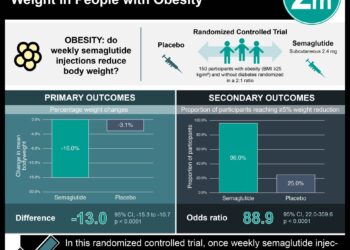The 2 Minute Medicine Podcast Episode 30
December 14th 2023
Welcome to the 2 Minute Medicine Podcast, summarizing the latest medical studies, curated and written by practicing physicians. On this podcast, twice a month, we cover the latest in healthcare news and research evidence.
Our episode is live!
Episode Description
We begin this episode by discussing our article of the week from the New England Journal of Medicine, entitled “Trial of Botulinum Toxin for Isolated or Essential Head Tremor”. In the second half, we discuss how as semaglutide, also known by brand names Ozempic or Wegovy, continues to make headlines, a new drug called Zepbound is entering the weight loss sphere. Next, we discuss organ transplants and a new antibiotic developed for the treatment of gonorrhea, Zoliflodacin. Last but not least, we discuss why March of Dimes, a maternal and infant health organization, issued a D+ to the USA for the 2nd year in a row for its relatively high rate of preterm births.
Click here to listen to this episode on Apple podcast
Click here to listen to this episode on Spotify
Transcript
[Deepti] Welcome to the 2 Minute Medicine Podcast, summarizing the latest medical studies, curated and written by practicing physicians.
For our full suite of daily medical study summaries and updates written by practicing doctors, please visit our website at 2minutemedicine.com to start reading new daily content right now, for free. On this podcast, twice a month, we cover the latest in health care news and research evidence. We are your hosts Deepti and Andrew. On today’s episode, we’ll start off by discussing our two articles of the week. In the second half of the episode, we will look at health issues that have arisen in popular media.
[Andrew] Our article of the week comes from the New England Journal of Medicine and is entitled “Trial of Botulinum Toxin for Isolated or Essential Head Tremor”. Essential tremor is the most common etiology of tremor and one of the most common movement disorders in adults. Botulinum toxin type A, which hinders pre-synaptic release of acetylcholine rendering decreased aberrant muscle movement, has shown varying degrees of efficacy in the treatment of essential hand tremor. However, previous randomized trials investigating its use for the treatment of head tremor are sparse and limited. This randomized, placebo-controlled trial aimed to investigate the efficacy and safety of botulinum toxin in the treatment of isolated or essential head tremor. Patients with isolated or essential head tremor with a rating of two or more on the Fahn-Tolosa-Marin Tremor Rating Scale were selected for the study. Those with dystonic head tremor or head tremor as part of a cerebellar syndrome were excluded. Patients were randomly assigned in a 1:1 ratio to receive botulinum toxin or placebo and injections were administered on day 0 and week 12 into each splenius capitis muscle under electromyographic guidance. The primary outcome was defined as an improvement by at least two points on the Clinical Global Impression of Change (CGI) scale at 18 weeks (six weeks after the second injection). Following the study, the primary outcome occurred in 19 of 62 patients (31%) in the botulinum toxin group versus 5 of 55 patients (9%) in the placebo group (relative risk, 3.37; 95% Confidence Interval [CI], 1.35 to 8.42; p=0.009). CGI score improvement by at least two points occurred in 44% of patients in the botulinum toxin group and 7% of patients in the placebo group at week 6 (relative risk, 5.99; 95% CI, 2.24 to 16.04); 29% and 9%, respectively, at week 12 (relative risk, 3.19; 95% CI, 1.27 to 8.03); and 23% and 13% at week 24 (relative risk, 1.77; 95% CI, 0.77 to 4.07), suggesting that the effects of the botulinum injections had likely waned by week 24, as expected. Adverse events were generally mild and occurred in 47% of patients in the botulinum toxin group versus 16% of patients in the placebo group including headache or neck pain, posterior cervical weakness, dysphagia, and pain at the injection sites. In summary, this study showed that botulinum toxin was effective in reducing the severity of isolated or essential head tremor at 18 weeks but not at 24 weeks.
[Andrew] Now for The Scan. The Story: As semaglutide, also known by brand names Ozempic or Wegovy, continues to make headlines, a new drug is entering the weight loss sphere. Zepbound, also known by its name tirzepatide, is already approved by the Food and Drug Administration (FDA) as Mounjaro. So, how does this work?
[Deepti]: Good question! Similar to semaglutide, tirzepatide works by reducing appetite, and the speed of gastric emptying, to help individuals feel more full after a meal. One key difference, is that while semaglutide mimics the effect of glucagon-like peptide 1 (GLP-1), tirzepatide mimics two hormones, GLP-1 and glucose-depending insulinotropic peptide (GIP). This allows it to produce a tremendous body weight reduction of 21% in clinical trials. Though it may seem like a miracle drug, doctors also highlight the importance of dietary modifications and resistance training in addition to the use of Zepbound. These issues are especially important to consider around the holidays.
[Andrew] In the wake of thanksgiving, and as the winter holidays approach, sharing large meals with family and friends becomes more common. The holiday fun may bring with it some anxiety surrounding eating, with nearly 63% of Americans reporting feelings of guilt associated with holiday binge eating. In addition to cultivation of good health habits such as regular exercise and eating fiber rich foods such as vegetables, the latest weight loss medications may help. Some tirzepatide users report less stress regarding food, alongside fewer feelings of pleasure associated with food. This allows some users to focus on enjoying the holidays with their family and friends, without thinking about food. These constant thoughts about food, are known as food noise. A welcome effect of weight loss medications is the reduction in food noise, which may ultimately lead to less thinking about food, especially during the holidays. Next, let’s discuss organ transplantation. Despite the ability to perform organ transplants, individuals receiving transplants are often at risk for transplant rejection, a condition that occurs when the immune system of the body rejects the transplanted organ. Recently, an experimental treatment saw a man receive a pig heart transplant, since he was ineligible for a transplant. The transplantation of non-human cells into humans is known as xenotransplantation, which may help the organ transplant waiting list.
[Deepti] That’s right. Xenotransplantation may help, since animal-derived organs are widely available, and the genes of these organs can be modified to better match those of humans. In the case of the patient with a recent pig heart transplant, he survived over a month, but ultimately showed signs of transplant rejection and passed away. Some patients benefit from their transplants and never experience transplant rejection. Some patients even go on to partake in mountain climbing. 25 years after receiving his heart transplant, Dale Shippam, a Toronto man aims to climb Mount Chimborazo, a mountain in Ecuador standing over 20,000 feet tall. This trek is not his first, as Shippam has completed arduous trips to the North and South pole, and to the base camp of Mt. Everest, as part of the Test Your Limits team. This is an initiative aiming to raise funds and awareness for heart failure research, cardiac transplantation, and heart health. Many hours of training and preparation will come together for the team as they ascend to Mt. Chimborazo. Next, let’s discuss a new treatment for Gonorrhea. As bacteria develop antibiotic resistance, problems in treating these bacteria can arise. One such example is that of gonorrhea, a sexually transmitted infection. Gonorrhea is caused by the Neisseria gonorrhoeae bacterium, which can infect mucous membranes, primarily in the reproductive tract but also in the eyes and throat. In 2020 alone, there were over 82 million new cases of gonorrhea worldwide, which if left untreated can lead to infertility alongside other complications.
[Andrew] Common signs and symptoms of gonorrhea include pain or burning during urination, as well as abnormal bleeding or discharge. Complications of gonorrhea include inflammation of the reproductive tract, as well potentially systemic symptoms if the bacteria spread to other locations throughout the body. Over time, N.gonorrhoeae has become resistant to fluoroquinolones, a class of antibiotics often used to treat gonorrhea infections in the past. Bacteria become resistant through a variety of mechanisms, but research has shown that some strains of N.gonorrhoeae develop genetic mutations that make them less susceptible to the effects of commonly used antibiotics. Current treatment for gonorrhea is a single injection of ceftriaxone, a member of the cephalosporin class of antibiotics. In Canada, combination therapy is used by adding another antibiotic, such as azithromycin, to ensure eradication and minimize the risk of resistant bacteria continuing to survive despite a single antibiotic. Due to the rapidly evolving nature of this bacteria, new antibiotics are critical in the fight against gonorrhea. Zoliflodacin, a new antibiotic developed for the treatment of gonorrhea, was equally effective compared to combination therapy in a recent clinical trial. Given the concern that gonorrhea may develop resistance to combination therapy, zoliflodacin represents a unique solution to the problem of antibiotic resistance in gonorrhea. It’s not a magic bullet though, since experts have shown that gonorrhoea can become resistant to zoliflodacin under certain conditions.
[Deepti] With this in mind, to ensure effective treatment against gonorrhea, it is crucial to consider principles of antibiotic stewardship, such as responsible antibiotic usage and prescription. Last but not least, we wanted to have a conversation about maternal and infant healthcare.
March of Dimes, a maternal and infant health organization, issued a D+ to the USA for the 2nd year in a row for its relatively high rate of preterm births. A preterm birth is defined as a baby born before the age of 37 weeks, and the USA saw a 10.4% rate of preterm infant birth in 2022.
Preterm birth is associated with many risks. Despite unclear mechanisms, babies born before 37 weeks seem to have an increased risk of asthma, feeding problems, and even sudden infant death syndrome, where an infant passes away due to unknown reasons. In the days and weeks following birth, babies born preterm may suffer from severe breathing problems, requiring ventilator use.
Infants born prematurely have variable survival rates, depending on how old the baby is upon birth. If labor is initiated, a variety of treatments can be started. Doctors may choose to give tocolytics, drugs intended to stop contractions to allow the baby to stay in the uterus for as long as possible, to maximize the chances of organ development. Corticosteroids may also be given, to increase the rate of proper lung development, if labor is occurring preterm and cannot be stopped. In addition to the baby, mothers that deliver preterm may experience extreme emotional impacts, which can lead to the development of anxiety, postpartum depression, and post-traumatic stress disorder.
Due to the possible negative outcomes, it is critical to understand what factors can influence preterm birth. Smoking and illicit substance use can increase risk of preterm labor, alongside factors such as stress, diabetes, and high blood pressure. In the report, nearly 29% of mothers experiencing preterm birth also had diabetes, and roughly 23% of mothers experiencing preterm birth had high blood pressure.
[Andrew] In the wake of this report, March of Dimes called for policy changes that may improve maternal and infant health care. In addition, the report highlighted racial disparities and underscored the importance of social determinants of health, to ensure the safety of infants and mothers alike during pregnancy and birth.
We’d like to acknowledge the following members of our team for their contributions to this week’s episode
- Neerav Mullur
- Junghoon Ko
- Kiera Liblik
Thank you for joining us today for this episode of the 2 Minute Medicine Podcast. New episodes come out every other week and all of our content has been curated and written by practicing physicians.
Please head to our website at 2minutemedicine.com to learn more and to access all of our content including medical study summaries, visual abstracts, excerpts from our Classics book series which is available on Amazon, and The Scan, which is our medical newsletter.
Thank you so much once again. To make sure that you don’t miss any of our content please subscribe and follow us on Twitter or Instagram @2MinMed
©2023 2 Minute Medicine, Inc. All rights reserved. No works may be reproduced without expressed written consent from 2 Minute Medicine, Inc. Inquire about licensing here. No article should be construed as medical advice and is not intended as such by the authors or by 2 Minute Medicine, Inc.



![2 Minute Medicine: Pharma Roundup: Price Hikes, Breakthrough Approvals, Legal Showdowns, Biotech Expansion, and Europe’s Pricing Debate [May 12nd, 2025]](https://www.2minutemedicine.com/wp-content/uploads/2025/05/ChatGPT-Image-May-12-2025-at-10_22_23-AM-350x250.png)







